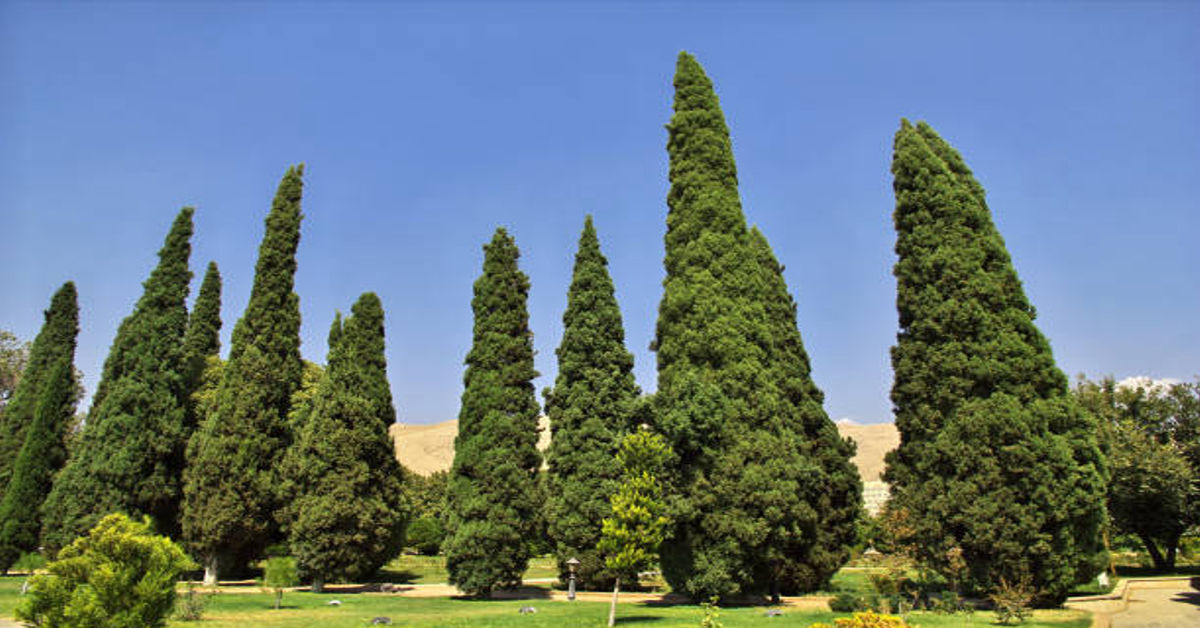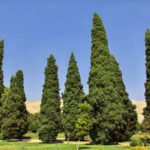The cypress tree is a remarkable and versatile species recognized for its beauty, resilience, and ecological importance. Belonging to the family Cupressaceae, cypress trees are conifers that thrive in a variety of environments, from swampy lowlands to dry, well-drained soils. Known for their tall, slender form, aromatic wood, and evergreen foliage, these trees have been valued for centuries in landscaping, construction, and cultural symbolism. This article delves deeply into the world of cypress trees, covering their taxonomy, physical characteristics, growth patterns, environmental preferences, ecological role, practical uses, cultivation methods, and common challenges associated with their care.
1. Introduction to Cypress Trees
Cypress trees are among the most recognizable and admired conifers in the world. Their aesthetic appeal is evident in parks, cemeteries, and urban landscapes, where they are often planted for their vertical, elegant form and longevity. Beyond their visual appeal, cypress trees serve important ecological functions, including soil stabilization, water purification in wetlands, and providing habitat for birds and insects. Historically, cypress wood has been used in construction, boat-building, and fine carpentry due to its durability, natural resistance to decay, and aromatic qualities.
The name “cypress” is derived from the Greek word “kyparissos”, reflecting the tree’s long-standing presence in Mediterranean culture and mythology. The species has also been symbolically associated with immortality, mourning, and protection, making it a culturally significant tree in many parts of the world.
2. Taxonomy and Classification
Cypress trees belong to the family Cupressaceae, which encompasses several genera and species known for their cone-bearing characteristics and evergreen foliage. Their taxonomic classification can be summarized as follows:
| Classification Level | Details |
|---|---|
| Kingdom | Plantae |
| Phylum | Tracheophyta |
| Class | Pinopsida |
| Order | Pinales |
| Family | Cupressaceae |
| Genus | Cupressus, Chamaecyparis, Taxodium (varies) |
| Species | Varies by region and type |
Different genera within the cypress family exhibit unique characteristics. For example, Cupressus species are often found in the Mediterranean and California regions, whereas Chamaecyparis species are more common in East Asia and North America. Taxodium, commonly known as bald cypress, thrives in swampy areas of the southeastern United States and is known for its “knees,” which protrude from waterlogged soil and aid in aeration.
3. Physical Characteristics
Cypress trees exhibit remarkable diversity in size, shape, and foliage. While the majority are tall and conical, some species have broader, spreading canopies. Their physical characteristics can be detailed as follows:
- Height and Shape: Cypress trees vary from medium-sized trees of 15–25 meters to towering giants exceeding 50 meters. Their form is usually conical or columnar, though some species exhibit a more irregular silhouette depending on environmental conditions.
- Bark: Thick, fibrous bark provides protection against fire and pests. The bark’s color ranges from reddish-brown to grayish tones and peels off in vertical strips in older trees.
- Foliage: Evergreen, scale-like leaves dominate most cypress species, though some have needle-like foliage. The leaves are aromatic due to natural oils that provide pest resistance.
- Cones: Cypress trees are gymnosperms and produce cones instead of flowers. Male cones release pollen, while female cones develop seeds over several months to years. Cones vary in size and shape by species.
Table 1: Physical Attributes of Common Cypress Species
| Species | Height (m) | Leaf Type | Cone Size (cm) | Special Features |
|---|---|---|---|---|
| Cupressus sempervirens | 20–35 | Scale-like | 2–3 | Tall, columnar, Mediterranean origin |
| Taxodium distichum | 30–50 | Needle-like | 2–5 | Swamp-adapted, produces “knees” |
| Chamaecyparis lawsoniana | 30–40 | Scale-like | 1–2 | Fragrant wood, ornamental |
| Cupressus arizonica | 15–25 | Scale-like | 2–3 | Drought-resistant, silver-blue foliage |
The diversity among cypress species makes them suitable for a wide range of climatic and soil conditions, and they have adapted to both wet and arid environments.
4. Habitat and Geographic Distribution
Cypress trees are highly adaptable and are found in multiple ecosystems around the world. Their natural habitats range from swampy wetlands to dry, rocky hillsides. The specific environmental conditions they prefer include:
- Climate: Cypress trees thrive in temperate to subtropical climates, tolerating a range of temperatures. Some species are frost-resistant, while others prefer warmer conditions.
- Soil: Well-drained, loamy soils are ideal, although species like Taxodium distichum grow in waterlogged, clay-rich soils. Soil pH preferences vary, but slightly acidic to neutral soils are generally favorable.
- Water Availability: While some cypress species tolerate drought, others require regular water sources, especially during early growth stages.
Geographic Distribution
| Region | Common Species | Habitat Type |
|---|---|---|
| Mediterranean | Cupressus sempervirens | Dry hills, rocky soils |
| Southeastern USA | Taxodium distichum | Swamps, riverbanks, floodplains |
| Western USA | Cupressus arizonica | Arid, rocky terrain |
| East Asia | Chamaecyparis obtusa | Forested mountains, ornamental |
This widespread distribution highlights the cypress tree’s adaptability and importance in various ecosystems, from natural forests to managed landscapes.
5. Growth and Development
Cypress trees have relatively slow growth compared to other conifers, but they can live for centuries under optimal conditions. Their growth patterns depend on species, climate, soil fertility, and water availability. Key aspects of growth include:
- Germination: Seeds require moist soil and moderate sunlight to germinate. Pre-soaking in water can enhance germination rates.
- Juvenile Phase: During the first few years, growth is relatively slow, focusing on root development to establish stability and nutrient absorption.
- Mature Growth: Once established, cypress trees exhibit vertical growth with dense foliage. Some species develop buttressed bases or cypress knees in swampy regions.
- Longevity: Many cypress trees live 200–600 years, with some species such as Cupressus sempervirens in the Mediterranean exceeding 1,000 years.
Table 2: Growth Characteristics of Selected Cypress Species
| Species | Growth Rate | Maturity Age (years) | Lifespan (years) | Special Adaptations |
|---|---|---|---|---|
| Cupressus sempervirens | Moderate | 15–20 | 500–1000 | Columnar growth, drought-tolerant |
| Taxodium distichum | Slow | 20–30 | 400–600 | Swamp survival, “knees” |
| Chamaecyparis lawsoniana | Moderate-Fast | 10–15 | 200–300 | Ornamental, fragrant wood |
| Cupressus arizonica | Moderate | 15–20 | 300–400 | Tolerates dry, rocky soils |
Understanding growth patterns is essential for cultivation and landscape planning, ensuring that cypress trees reach their full potential in both ecological and aesthetic contexts.
6. Ecological Role
Cypress trees contribute significantly to their ecosystems in various ways:
- Habitat Provision: Birds, insects, and small mammals use cypress trees for nesting, shelter, and foraging.
- Soil Stabilization: Their deep root systems prevent soil erosion, particularly along riverbanks and in flood-prone areas.
- Water Regulation: Swamp-adapted species, such as bald cypress, improve water quality by filtering sediment and absorbing excess nutrients.
- Carbon Sequestration: As long-lived trees, cypress species store significant amounts of carbon, helping mitigate climate change.
- Biodiversity Support: Their presence supports understory plants, fungi, and microorganisms, creating a micro-ecosystem around the tree.
Table 3: Ecological Benefits of Cypress Trees
| Benefit | Description |
|---|---|
| Habitat Support | Provides shelter and nesting sites for wildlife |
| Soil Protection | Reduces erosion, stabilizes riverbanks |
| Water Filtration | Absorbs nutrients and traps sediment |
| Climate Mitigation | Stores carbon, reduces atmospheric CO2 |
| Biodiversity Enhancement | Supports plants, fungi, and insect populations |
The ecological significance of cypress trees underscores the importance of preserving natural stands and incorporating them into sustainable landscaping practices.
7. Uses of Cypress Trees
Cypress trees have been valued for multiple practical purposes throughout human history. These include:
- Wood and Timber: Cypress wood is highly durable, resistant to decay, and aromatic. It is used in furniture, boat building, flooring, and cabinetry.
- Ornamental Landscaping: Cypress trees are frequently planted in gardens, parks, and along streets for aesthetic appeal. Their columnar form is ideal for vertical accents.
- Medicinal Uses: Essential oils extracted from cypress foliage have been used in traditional medicine for their antiseptic and anti-inflammatory properties.
- Cultural and Symbolic Importance: Historically, cypress trees symbolize immortality, mourning, and protection in Mediterranean and Asian cultures.
- Environmental Applications: Swamp-adapted species improve water quality, provide habitat, and prevent flooding in wetland ecosystems.
8. Cultivation and Maintenance
Cypress trees are relatively low-maintenance but require attention during the early stages of growth.
- Planting: Choose well-drained soil with adequate sunlight. Space trees according to expected mature size.
- Watering: Newly planted trees need regular watering; mature trees are drought-tolerant depending on species.
- Pruning: Minimal pruning is required, mainly to remove dead or diseased branches.
- Fertilization: Occasional fertilization supports growth in nutrient-poor soils. Organic compost is recommended.
- Pest and Disease Management: Watch for cypress canker, aphids, and root rot. Proper spacing and good drainage minimize disease risks.
Table 4: Cypress Tree Care Guidelines
| Aspect | Recommendation |
|---|---|
| Soil Type | Well-drained, slightly acidic to neutral |
| Sunlight | Full sun to partial shade |
| Watering | Moderate; increase during first 2–3 years |
| Fertilization | Once or twice a year with organic compost |
| Pruning | Remove dead/diseased branches, shape occasionally |
9. Challenges in Cypress Tree Cultivation
While resilient, cypress trees can face several challenges:
- Cypress Canker: A fungal disease that causes dieback of branches. Early detection and pruning of infected areas are critical.
- Pests: Aphids, spider mites, and bark beetles can damage foliage and weaken the tree.
- Drought Stress: While some species tolerate dry conditions, prolonged droughts can stunt growth.
- Poor Drainage: Waterlogged soils can lead to root rot in non-swamp-adapted species.
- Climate Sensitivity: Extreme cold or hot temperatures outside the tree’s natural range may affect survival.
Preventive measures, such as proper site selection, soil management, and monitoring, ensure healthy growth.
10. Fun Facts About Cypress Trees
- Some Mediterranean cypress trees have lived for over 1,000 years, making them symbols of longevity.
- Bald cypress “knees” in wetlands help the tree breathe in oxygen-poor soils.
- Cypress wood is naturally resistant to termites and decay, making it highly durable.
- They are evergreen, maintaining foliage year-round, providing constant habitat and aesthetic value.
- Cypress trees are often planted as windbreaks and privacy screens due to their dense growth.
11. Conclusion
Cypress trees are extraordinary plants with ecological, cultural, and economic significance. From their majestic appearance to their resilience in diverse environments, they continue to captivate humans and support ecosystems. Proper understanding of their growth, habitat, and care requirements ensures these trees thrive for centuries, benefiting both people and the environment. Incorporating cypress trees in urban planning, forestry, and landscaping not only enhances aesthetic appeal but also strengthens ecological sustainability.
FAQs
1. What is a cypress tree?
A cypress tree is a coniferous, evergreen tree known for its tall, columnar shape, aromatic wood, and ecological importance.
2. Where do cypress trees grow naturally?
They grow in Mediterranean regions, North America, East Asia, and swampy wetlands, depending on species and climate.
3. How long do cypress trees live?
Many species live 200–600 years, with some Mediterranean cypresses exceeding 1,000 years.
4. What are the uses of cypress trees?
Cypress trees are used for timber, landscaping, medicinal oils, cultural symbolism, and environmental restoration.
5. How should I care for a cypress tree?
Provide well-drained soil, adequate sunlight, moderate watering, occasional pruning, and pest monitoring for optimal growth.











